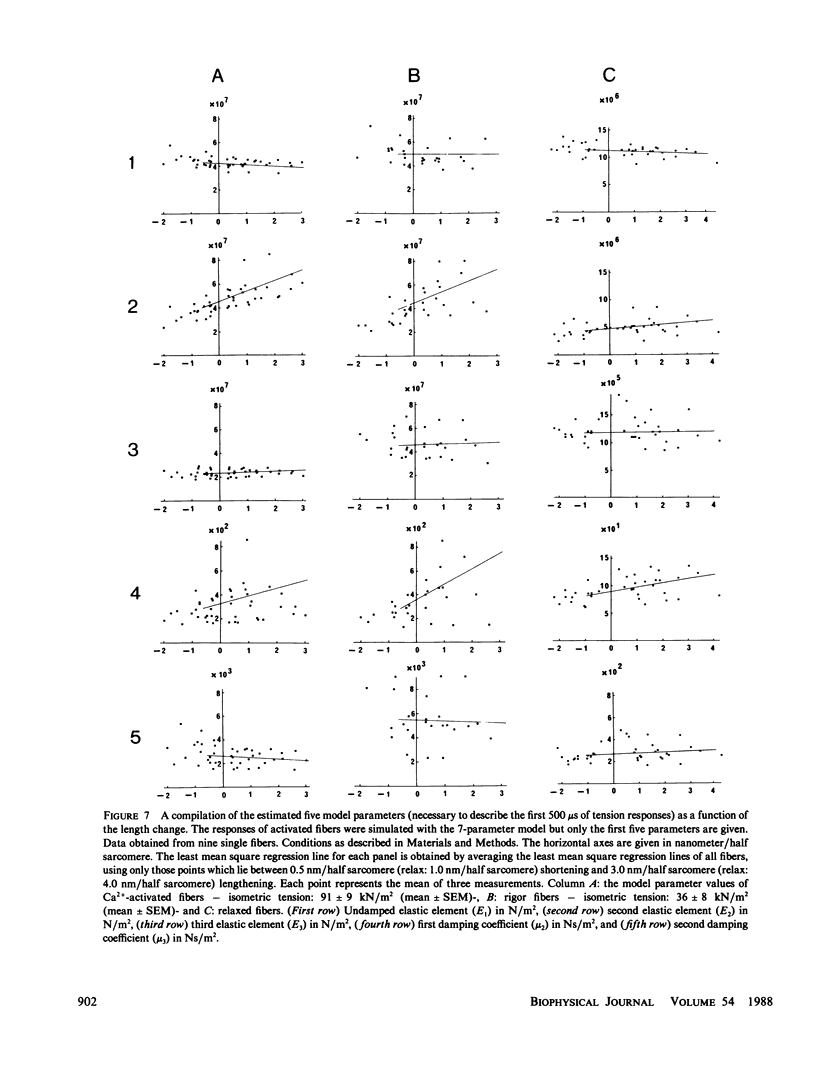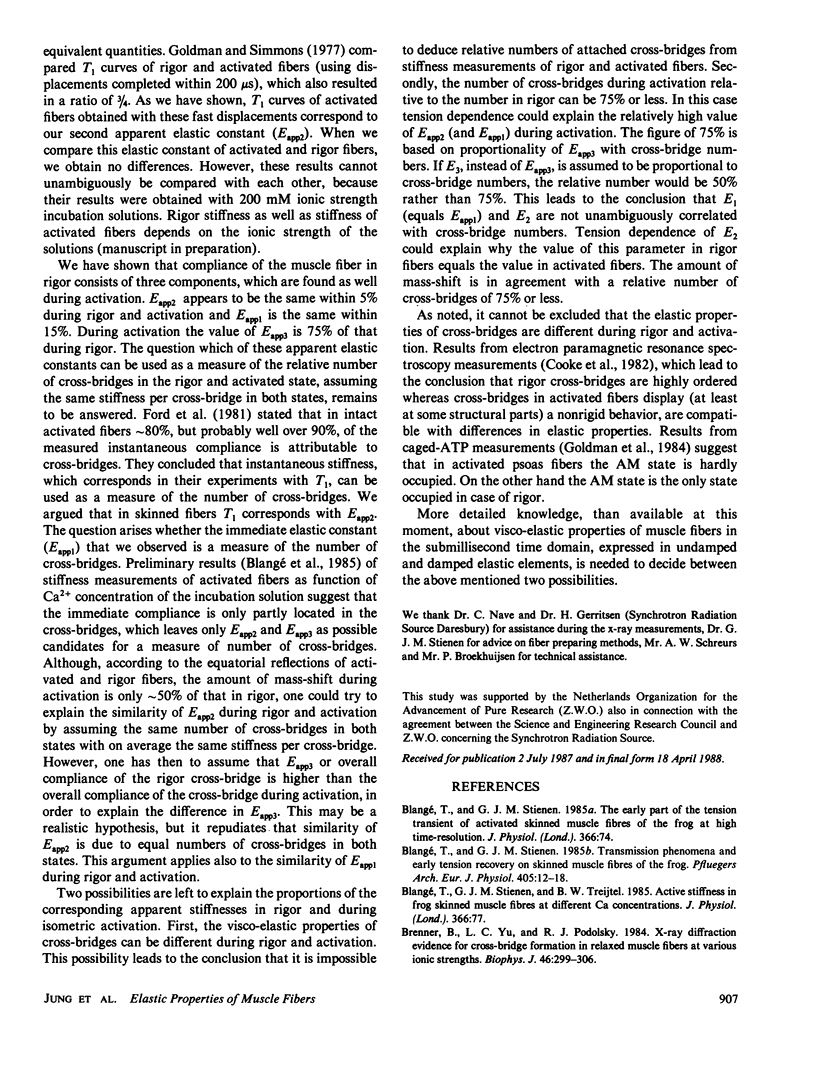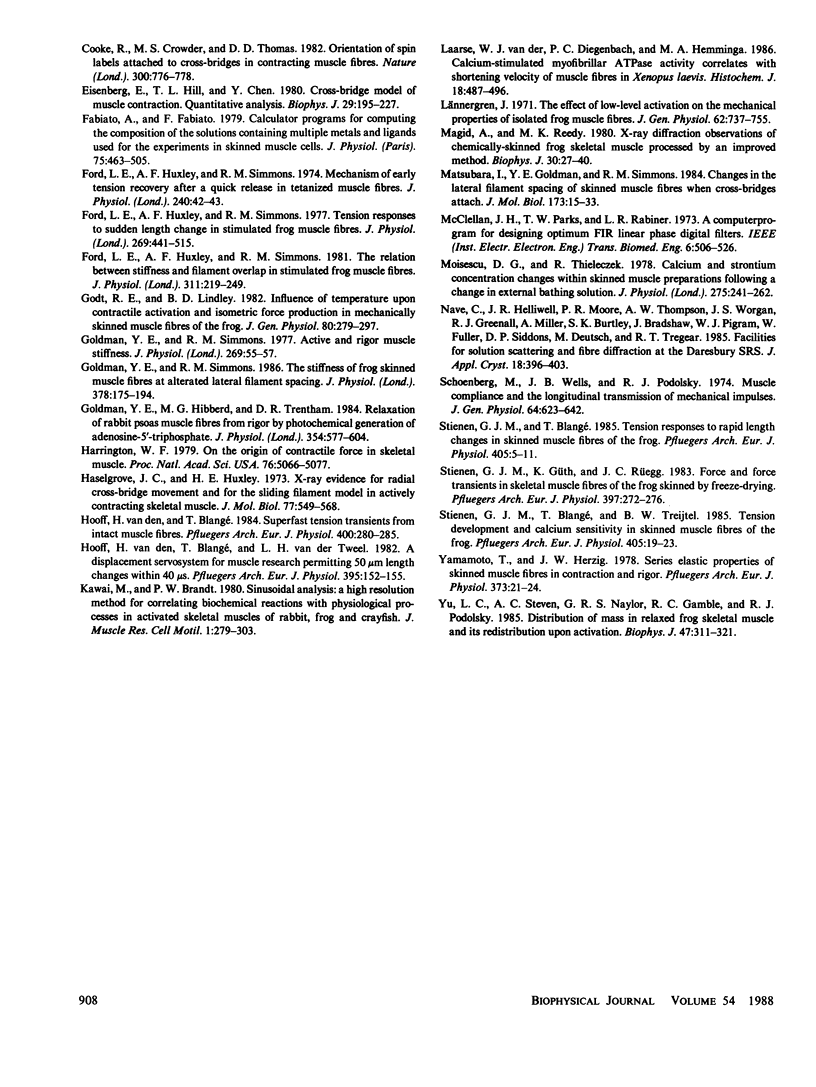Abstract
Tension responses due to small and rapid length changes (completed within 40 microseconds) were obtained from skinned single-fiber segments (4- to 7-mm length) of the iliofibularis muscle of the frog incubated in relaxing, rigor, and activating solution. The fibers were skinned by freeze-drying. The first 500 microseconds of the responses for all three conditions could be described with a linear model, in which the fiber is regarded as a rod composed of infinitesimally small identical segments, containing an undamped elastic element, two damped elastic elements and a mass in series. An additional damped elastic element was needed to describe tension responses of activated fibers up to the first 5 ms. Consequently phase 1 and phase 2 of activated fibers can be described with four apparent elastic constants and three time constants. The results indicate that fully activated fibers and fibers in rigor have similar elastic properties within the first 500 microseconds of tension responses. This points either to an equal number of attached cross-bridges in rigor and activated fibers or to a different number of attached cross-bridges in rigor and activated fibers and nonlinear characteristics in rigor cross-bridges. Mass-shift measurements obtained from equatorial x-ray diffraction patterns support the latter possibility.
Full text
PDF











Selected References
These references are in PubMed. This may not be the complete list of references from this article.
- Blangé T., Stienen G. J. Transmission phenomena and early tension recovery in skinned muscle fibres of the frog. Pflugers Arch. 1985 Sep;405(1):12–18. doi: 10.1007/BF00591091. [DOI] [PubMed] [Google Scholar]
- Brenner B., Yu L. C., Podolsky R. J. X-ray diffraction evidence for cross-bridge formation in relaxed muscle fibers at various ionic strengths. Biophys J. 1984 Sep;46(3):299–306. doi: 10.1016/S0006-3495(84)84026-6. [DOI] [PMC free article] [PubMed] [Google Scholar]
- Cooke R., Crowder M. S., Thomas D. D. Orientation of spin labels attached to cross-bridges in contracting muscle fibres. Nature. 1982 Dec 23;300(5894):776–778. doi: 10.1038/300776a0. [DOI] [PubMed] [Google Scholar]
- Eisenberg E., Hill T. L., Chen Y. Cross-bridge model of muscle contraction. Quantitative analysis. Biophys J. 1980 Feb;29(2):195–227. doi: 10.1016/S0006-3495(80)85126-5. [DOI] [PMC free article] [PubMed] [Google Scholar]
- Fabiato A., Fabiato F. Calculator programs for computing the composition of the solutions containing multiple metals and ligands used for experiments in skinned muscle cells. J Physiol (Paris) 1979;75(5):463–505. [PubMed] [Google Scholar]
- Ford L. E., Huxley A. F., Simmons R. M. Tension responses to sudden length change in stimulated frog muscle fibres near slack length. J Physiol. 1977 Jul;269(2):441–515. doi: 10.1113/jphysiol.1977.sp011911. [DOI] [PMC free article] [PubMed] [Google Scholar]
- Ford L. E., Huxley A. F., Simmons R. M. The relation between stiffness and filament overlap in stimulated frog muscle fibres. J Physiol. 1981 Feb;311:219–249. doi: 10.1113/jphysiol.1981.sp013582. [DOI] [PMC free article] [PubMed] [Google Scholar]
- Godt R. E., Lindley B. D. Influence of temperature upon contractile activation and isometric force production in mechanically skinned muscle fibers of the frog. J Gen Physiol. 1982 Aug;80(2):279–297. doi: 10.1085/jgp.80.2.279. [DOI] [PMC free article] [PubMed] [Google Scholar]
- Goldman Y. E., Hibberd M. G., Trentham D. R. Relaxation of rabbit psoas muscle fibres from rigor by photochemical generation of adenosine-5'-triphosphate. J Physiol. 1984 Sep;354:577–604. doi: 10.1113/jphysiol.1984.sp015394. [DOI] [PMC free article] [PubMed] [Google Scholar]
- Goldman Y. E., Simmons R. M. The stiffness of frog skinned muscle fibres at altered lateral filament spacing. J Physiol. 1986 Sep;378:175–194. doi: 10.1113/jphysiol.1986.sp016213. [DOI] [PMC free article] [PubMed] [Google Scholar]
- Harrington W. F. On the origin of the contractile force in skeletal muscle. Proc Natl Acad Sci U S A. 1979 Oct;76(10):5066–5070. doi: 10.1073/pnas.76.10.5066. [DOI] [PMC free article] [PubMed] [Google Scholar]
- Haselgrove J. C., Huxley H. E. X-ray evidence for radial cross-bridge movement and for the sliding filament model in actively contracting skeletal muscle. J Mol Biol. 1973 Jul 15;77(4):549–568. doi: 10.1016/0022-2836(73)90222-2. [DOI] [PubMed] [Google Scholar]
- Kawai M., Brandt P. W. Sinusoidal analysis: a high resolution method for correlating biochemical reactions with physiological processes in activated skeletal muscles of rabbit, frog and crayfish. J Muscle Res Cell Motil. 1980 Sep;1(3):279–303. doi: 10.1007/BF00711932. [DOI] [PubMed] [Google Scholar]
- Magid A., Reedy M. K. X-ray diffraction observations of chemically skinned frog skeletal muscle processed by an improved method. Biophys J. 1980 Apr;30(1):27–40. doi: 10.1016/S0006-3495(80)85074-0. [DOI] [PMC free article] [PubMed] [Google Scholar]
- Matsubara I., Goldman Y. E., Simmons R. M. Changes in the lateral filament spacing of skinned muscle fibres when cross-bridges attach. J Mol Biol. 1984 Feb 15;173(1):15–33. doi: 10.1016/0022-2836(84)90401-7. [DOI] [PubMed] [Google Scholar]
- Moisescu D. G., Thieleczek R. Calcium and strontium concentration changes within skinned muscle preparations following a change in the external bathing solution. J Physiol. 1978 Feb;275:241–262. doi: 10.1113/jphysiol.1978.sp012188. [DOI] [PMC free article] [PubMed] [Google Scholar]
- Schoenberg M., Wells J. B., Podolsky R. J. Muscle compliance and the longitudinal transmission of mechanical impulses. J Gen Physiol. 1974 Dec;64(6):623–642. doi: 10.1085/jgp.64.6.623. [DOI] [PMC free article] [PubMed] [Google Scholar]
- Stienen G. J., Blangé T. Tension responses to rapid length changes in skinned muscle fibres of the frog. Pflugers Arch. 1985 Sep;405(1):5–11. doi: 10.1007/BF00591090. [DOI] [PubMed] [Google Scholar]
- Stienen G. J., Blangé T., Treijtel B. W. Tension development and calcium sensitivity in skinned muscle fibres of the frog. Pflugers Arch. 1985 Sep;405(1):19–23. doi: 10.1007/BF00591092. [DOI] [PubMed] [Google Scholar]
- Stienen G. J., Güth K., Rüegg J. C. Force and force transients in skeletal muscle fibres of the frog skinned by freeze-drying. Pflugers Arch. 1983 Jun 1;397(4):272–276. doi: 10.1007/BF00580260. [DOI] [PubMed] [Google Scholar]
- Yamamoto T., Herzig J. W. Series elastic properties of skinned muscle fibres in contraction and rigor. Pflugers Arch. 1978 Jan 31;373(1):21–24. doi: 10.1007/BF00581144. [DOI] [PubMed] [Google Scholar]
- Yu L. C., Steven A. C., Naylor G. R., Gamble R. C., Podolsky R. J. Distribution of mass in relaxed frog skeletal muscle and its redistribution upon activation. Biophys J. 1985 Mar;47(3):311–321. doi: 10.1016/S0006-3495(85)83921-7. [DOI] [PMC free article] [PubMed] [Google Scholar]
- van den Hooff H., Blangé T. Superfast tension transients from intact muscle fibres. Pflugers Arch. 1984 Mar;400(3):280–285. doi: 10.1007/BF00581560. [DOI] [PubMed] [Google Scholar]
- van den Hooff H., Blangé T., van der Tweel L. H. A displacement servosystem for muscle research permitting 50 micrometers length changes within 40 microseconds. Pflugers Arch. 1982 Nov 1;395(2):152–155. doi: 10.1007/BF00584729. [DOI] [PubMed] [Google Scholar]
- van der Laarse W. J., Diegenbach P. C., Hemminga M. A. Calcium-stimulated myofibrillar ATPase activity correlates with shortening velocity of muscle fibres in Xenopus laevis. Histochem J. 1986 Sep;18(9):487–496. doi: 10.1007/BF01675616. [DOI] [PubMed] [Google Scholar]


